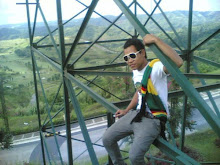
MT. CRISTOBAL
Dolores, Quezon; San Pablo and Nagcarlan, LagunaMajor jump-off: Brgy. Sta. Lucia, Dolores, QuezonLLA: 14.064° N 121.428° E, 1470 MASL (600m gain)Days required / Hours to summit: 1-2 days / 4-5 hoursSpecs: Minor climb, Difficulty 4/9, Trail class 3
BACKGROUND
Countless legends surround Mt. Cristobal. With its summit taking on a characteristic 'W' shape, like that of stealth bomber, it is flanked by the grander Mt. Banahaw to its northeast, and together, they figure prominently in folklore. For instance, it is said that while Mt. Banahaw is a holy mountain, Mt. Cristobal is the "Devil's mountain", and the two mountains possess good and evil energies that cancel out. The primeval forests of Cristobal, decked with ferns and thorny plants, culminating in its ancient crater, seem to fit the bill of an eerie mountain. Furthermore, there are tales of voices or apparitions, such as the creature called 'Tumao', waylaying mountain climbers; many hiking groups have their own "ghost stories" to tell. Even locals believe these stories; some guides say they have amulets to counteract the negative energy.These legends notwithstanding, there is no reason to be afraid of Mt. Cristobal. Its forests are pristine, with a splendid array of flora that include giant pakpaklawin, varicolored flowering plants, rattan, etc. Two types of civet cats, the musang and the animus, roam freely in the forests. There are also reptile species, including those locally known as the bubuli and the balikakas.
THE DOLORES TRAIL
The Dolores trail is by far the most common trail used to climb Mt. Cristobal. This trail commences just before you enter Brgy. Kinabuhayan (the jump-off to Mt. Banahaw). To your left, there is trail; you could see the range-like Mt. Cristobal looming to the west. A thirty-minute walk, through on-and-off cemented paths, would take you to house of the psychic, Montelibano. There are citrus fruits (dalanghita) along the way. From the Montelibano house, the forest ensues, taking 2-3 hours to cross. Take note of the ferns that demarcate
the trail all throughout. Occasionally, there would be views of Tayabas Bay, with Mt. Daguldul to the west and, on a very clear day, Marinduque to the south. Due to the dense forest, however, panoramic views are rare. Further up the jungle, the western portion of the crater rim would have a striking resemblance with the Rockies of Mt. Maculot. The trail is pretty straightforward; there's only one confusing fork, marked by a big rock. Go straight to the right trail. At 1130 MASL, you will cross the cogon line.
ITINERARYDOLORES
(STA. LUCIA) TRAIL0500 ETD Manila0700 ETA San Pablo City (bus:P120). Rent jeep to Brgy. Kinabuhayan0800 ETA jump-off at Brgy. Kinabuhayan. Start trek0840 ETA Montelibano house1100 ETA crater rim; descend to crater1130 ETA Crater.1200 ETA Jones' Peak (highest point in trail)1230 Start descent1530 Back at the jump-off1600 Head back to San Pablo1700 ETA San Pablo2000 ETA Manila
Useful numbers include those of the Quezon Provincial Police Office, +63427102351, +63427103101. A nearby hospital is San Pablo City Doctors' Hospital, +63495627992.
TRIVIA
During coffee season, around January, the civet cats feed on coffee beans and excrete them undigested. These excreted beans litter the trails and are a sought-after delicacy, fetching thousands per kilo in Europe. The explanation is, because of the cats' acute sense of smell, they are able to select the best beans.The Cristobal trails are one of the cleanest mountain trails. When asked why, our local guide said: "Because only mountaineers climb here." His words are a shining testimony of hikers' reputation; hopefully we will be able to live up to this name in the future, in Cristobal and elsewhere.On a humorous endnote: The author first climbed Mt. Cristobal via Brgy. San Cristobal. What was supposed to be a daytrip become an overnight adventure. We spent the night in the inclined cogon slopes, 1275 MASL. When our companion woke up, his sandals were gone! The malignant spirits of Cristobal at play? Lacking provisions, he had to descent through the dense forests and woodlands – all the way to his home in San Pablo – barefoot!
 TAU GAMMA PHI
TAU GAMMA PHI BROD: BRAYAN
BROD: BRAYAN BROD: MARKA
BROD: MARKA BROD: TOTO
BROD: TOTO BROD: MACKY
BROD: MACKY BROD: KiNO
BROD: KiNO BROD: RAVEN (pach-3 chapter)
BROD: RAVEN (pach-3 chapter)







